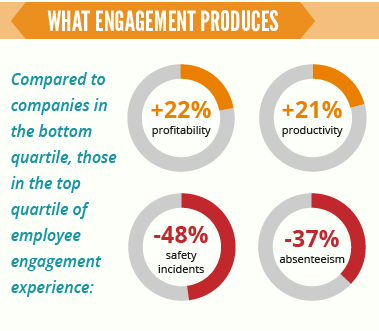 Regular readers know I believe in putting people first. When people work in teams, individuals need to know what matters from an organizational perspective. As we often say at Intertech, “There is no ‘I’ in team!”
Regular readers know I believe in putting people first. When people work in teams, individuals need to know what matters from an organizational perspective. As we often say at Intertech, “There is no ‘I’ in team!”
As a manager, you have a special responsibility to lead and help your team members grow – as individuals and as team members. This next series of posts will share my thoughts on this important topic, as originally noted in my new book, “The 100: Building Blocks for Business Leadership.”
Engagement, which I covered in earlier posts, bears another mention in this series on leading and managing teams. Why? Keeping people motivated goes a long way toward building effective teams and reducing attrition.
New research by Gallup suggests that a vast majority of people are not motivated at work. Another survey, recently released by the Associated Press, found that more than 70 percent of workers are opting for early retirement even though it means receiving lower Social Security benefits. This suggests to me a lack of engagement.
So how can you keep your people motivated?
Don’t be afraid to push employees beyond their professional comfort zones (although give new employees a few months to adjust before you ask them to “up their game!”). Motivated employees want to build their skills by working with high-profile companies on challenging assignments. We help to make that happen by building in a specific learning goal into each employee’s performance plan at the beginning of each year and even occasionally turning down client projects that might bore our people to tears. Less experienced employees are encouraged to work on internal projects that help our firm, while helping them learn new skills (but not on our clients’ dime).
Of course, challenging work that engages employee strengths is key to helping folks stay motivated. Sadly, a whopping 80 percent of U.S. workers say they do not use their strengths every day (Gallup 2013). Savvy managers make an effort to match the needs of their clients with the needs of employees to stay challenged. It also helps to let people know how they rate compared to others and how they fit within the overall organization. Mostly, though, employees need to know that the work they are doing is important–that it matters—as an individual and as a team.
Much of what I’ve been talking about describes a perfect world: engaged, motivated employees happily learning new skills while doing top-notch work for customers. Yet, even though I dread admitting it, the world in which we live and work is rarely perfect. Sometimes our long-time clients need our help with work that is, frankly, boring. To make matters worse, that work can be repetitive with significant time pressure, with no end in sight. While this may sound like a work nightmare, there are things leaders can do to help employees get through the challenge while avoiding burnout. Believe me, it’s in your interest to do so – otherwise you risk losing your best people to other employers. Here’s what we do to help employees deal with mind-numbing assignments:
- Verbally recognize the nature of the task and express our gratitude
- Offer more interesting additional assignments or a training opportunity
- Put a time cap on the dreary assignment (most people can endure almost anything if they know when it will end)

 To keep morale and motivation high, it’s essential to motivate your top performers as well those who need to improve and those who need to be shown the door. There’s a shorthand code for these three groups of employees:
To keep morale and motivation high, it’s essential to motivate your top performers as well those who need to improve and those who need to be shown the door. There’s a shorthand code for these three groups of employees: